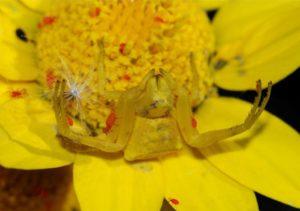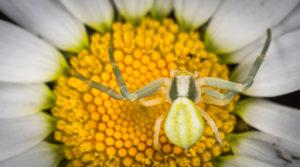Side walker spiders: small but brave and useful predators
Spiders are a large group of arthropods. Each type is unique in its own way and has certain features. One of the most interesting and widespread representatives of this order is the family of sidewalk spiders.
Content
What does a sidewalk look like: photo
Name: Spiders side walkers, unequal-legged, crab
Latin: ThomisidaeClass: Arachnida - Arachnida
Squad: Spiders - Araneae
 | Habitats: | everywhere |
 | Dangerous for: | small insects, pests |
 | Attitude towards people: | bites but not dangerous |
Sidewalker spiders are a family of small arachnids that are also called unequal sidewalker spiders, crab spiders, or crab spiders. This family includes more than 1500 different species.
This family of spiders got its name because of the ability to move sideways like crabs.
This ability to move sidewalk spiders was obtained due to the special structure of the limbs. The first and second pairs of legs are much better developed than the third and fourth. Also, it is worth noting the special location of these legs. Their front side is turned up, similar to how the claws of crabs are located.
The body length of sidewalk spiders usually does not exceed 10 mm. The body shape is rounded, slightly flattened. The color of representatives of this family varies depending on the habitat of the species and varies from bright, saturated shades of yellow and green to inconspicuous shades of gray and brown.
Features of breeding crab spiders
The female guards the cocoon with future offspring until the moment they hatch from the eggs and can go to live on their own. The number of young spiderlings emerging from one cocoon can reach 200-300 individuals.
Crab spider lifestyle
Spiders from the family of side walkers are quite lazy and spend almost all their time in ambush, waiting until a potential victim is nearby.
Sidewalk spider dwelling
Representatives of this family do not weave webs from the web and do not dig holes. Most often, sidewalk spiders equip their home in the following places:
- dense thickets of grass;
- flowers;
- shrubs;
- cracks in the bark of trees.
Crab spider diet
Sidewalk spiders are considered one of the most voracious representatives of arachnids. Their diet may include:
- bees;
- flies;
- butterflies;
- bumblebees;
- Colorado beetles;
- aphid;
- Bugs;
- long-nosed;
- apple honeydews.
The harm and benefits of sidewalk spiders
The main harm that representatives of this family bring is the destruction of honey bees. Beneficial pollinators are very often preyed upon by flower sidewalker spiders. Due to its too good appetite, this small spider can kill and eat 2-4 bees in one day.
As for the benefits, sidewalk spiders play a very important role in nature and control the number of harmful insects.
Crab spider venom
The poison of spiders of this family plays a serious role in medicine. Based on it, various drugs are being developed that help in the treatment of the following diseases:
- arrhythmia;
- Alzheimer's disease;
- erectile dysfunction;
- stroke.
Is the bite of a side-walker spider dangerous for humans?
The bite of a crab spider does not pose a serious danger to a healthy adult, but can cause the following symptoms:
- weakness;
- redness and swelling at the bite site;
- itching and burning;
- dizziness and headache.
It is worth considering that for allergy sufferers, people with weak immunity and young children, the bite of a sidewalk spider can be very dangerous.
Sidewalk spider habitat
The habitat of representatives of this family covers almost the entire globe. The only areas that are not inhabited by this arthropod species are:
- Arctic;
- mainland Antarctica;
- the island of Greenland.
The most popular types of sidewalk spiders
The number of species that are included in the sidewalker family is quite large, but its most famous representatives are:
- Flower spider. Body size up to 10 mm. The body is painted white, yellow or green.
- Yellow crab spider. The body in length does not exceed 5-7 mm.
- Cinema decorated. Reach 7-8 mm in length. The color of the body and limbs is black. The upper side of the abdomen is decorated with a large, clearly visible pattern of yellow or red.
Interesting facts about crab spiders
In addition to the unusual way of transportation, representatives of this family have several other interesting talents in their arsenal:
- in one day, spiders from this family can eat such an amount of food, the weight of which exceeds the mass of their own body;
- due to the special structure of the limbs, sidewalk spiders can move not only left and right, but also forward and backward;
- white sidewalk spiders are able to change the color of their body from white to yellow, and vice versa.
Conclusion
Sidewalker spiders are a widespread and numerous species, and they are very easy to meet outside the city. If you do not take into account their addiction to eating honey bees, then we can safely consider this family of spiders to be extremely useful representatives of the fauna. Thanks to their "brutal" appetite, they simply destroy a huge number of dangerous garden and garden pests.
Previous

